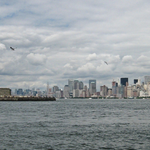By any metric, Alexandria, the second-largest city in Egypt, is an ancient place. It has survived the millennia since its founding in 331 BC, through rule by the Greek, Roman, Byzantine, Ottoman, French, and British Empires, into the modern Egyptian Republic it has been a part of since 1953. As such, it is perhaps of little surprise to learn that the bustling port city of more than 4.5 million inhabitants is home to Africa's oldest, and last of only a handful of continuously running streetcar networks left in operation anywhere in the world. With 140 stations spread across a 32-kilometre network comprised of 20 discreet lines, the compact-but-dense Alexandria Tramway is indeed one among many marvels located within the ancient city, its history an integral part of Alexandria's storied past. This edition of Once Upon a Tram will take an in-depth look at the 153-year history of the Alexandria Tramway, at the network and its historic patchwork fleet that are a prime example of modern-day antiquity in action.
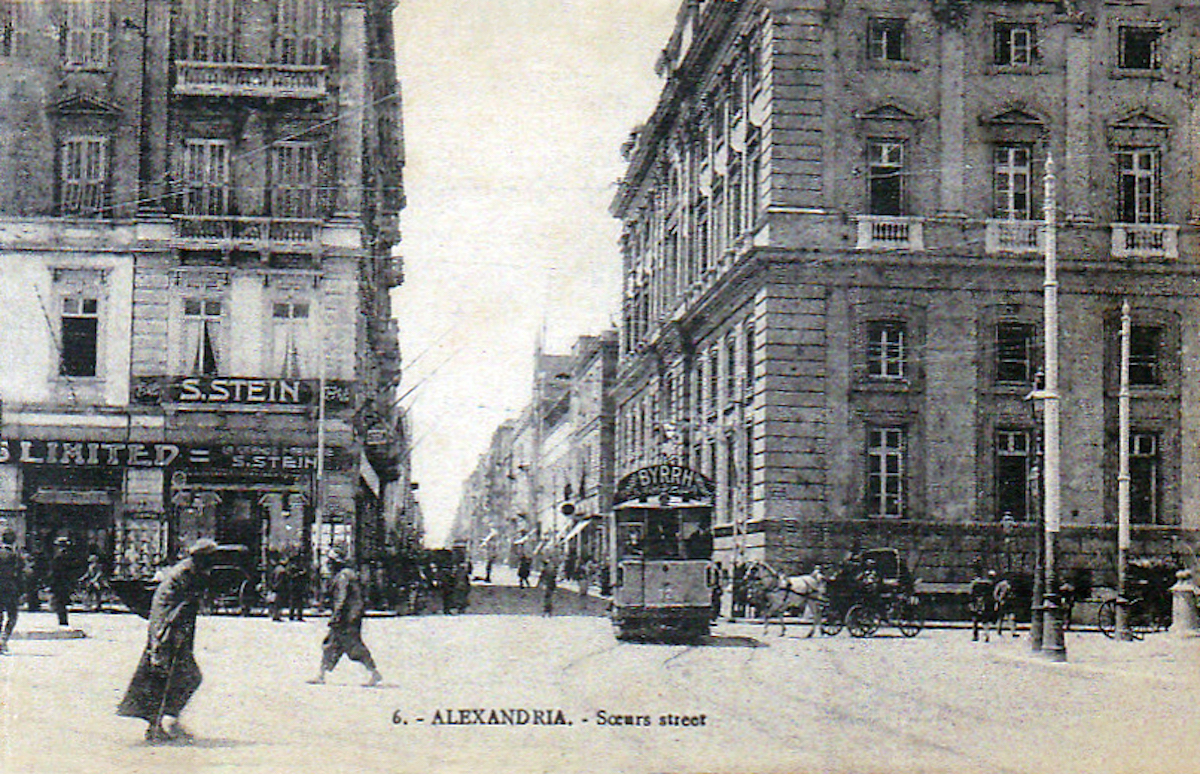 Alexandria, Soeurs Street, c. 1900, postcard view, public domain archival image
Alexandria, Soeurs Street, c. 1900, postcard view, public domain archival image
Begun in 1860 by English businessman Sir Edward Firman, the Alexandria Tramway was a joint venture between foreign investors and the local government. Following a few years of negotiations, planning, and construction, the Tramway opened on January 8, 1863 in the central district known then as Cleopatra's Needle, and known today as Ramleh Station. Similar to most early street rail services, the Alexandria Tramway was first powered by horses, its four-carriage trams pulled by a team of four. These early trams were arranged by class, with a somewhat larger First Class car up front, followed by three smaller cars, including two Second Class cars and a single Third Class car taking up the rear.
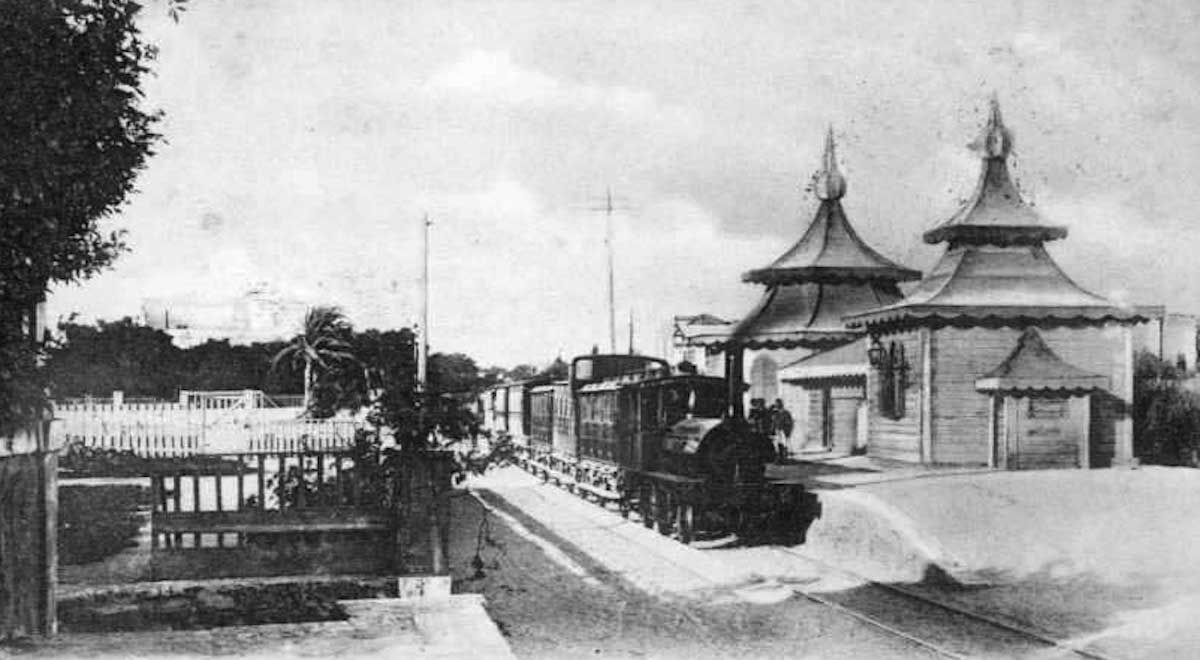 Steam-powered tram in operation, c. 1890, postcard view, public domain archival image
Steam-powered tram in operation, c. 1890, postcard view, public domain archival image
By August, 1863, just seven months after the Tramway's debut, the service was switched over to steam power in a move that predated the majority of street rail networks around the globe, with many in Europe and North America retaining horse-powered cars right up until the era of electrification which began in the 1890s. Viewed above, an archival view of Fleming Station, about 20 minutes outside of Alexandria, shows an example of steam-powered commuter rail in action, a service which would have connected the suburbs to the city centre.
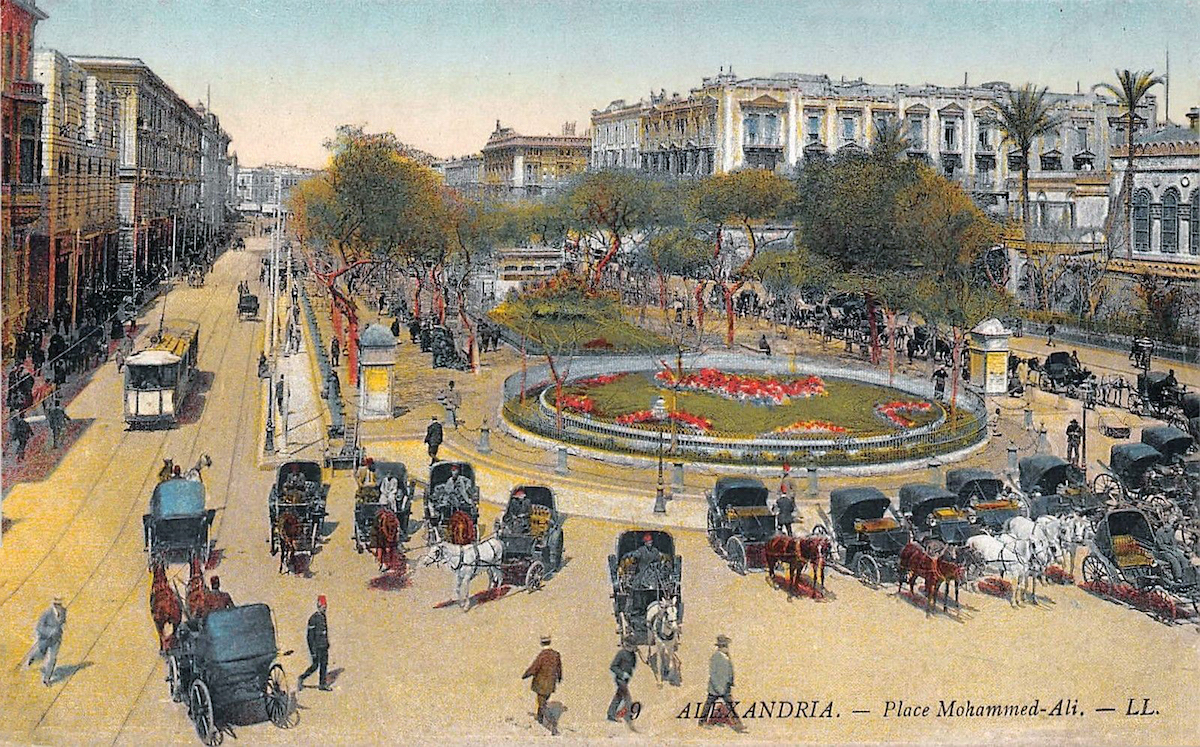 Mohammed Ali Square, c. 1900, postcard view, public domain archival image
Mohammed Ali Square, c. 1900, postcard view, public domain archival image
By the 1880s, Alexandria had blossomed into a thriving port city, its layout and architecture reflecting the strong European influences — namely French and British — at play. Its medieval streets were blown out into grand boulevards and public squares, and the laying of modern, eventually electrified, streetcar track was a beacon of progress within the heavily colonialized Egyptian city. In 1882, the British further invested in the Alexandria Tramway, followed by an even larger investment by a Belgian rail company in 1897, who bought the rights to the Tramway, which thereafter became known as the Alexandria Tramway Company. Following its European takeover, the Alexandria Tramway began the process of electrification, in keeping with similar street rail systems around the world.
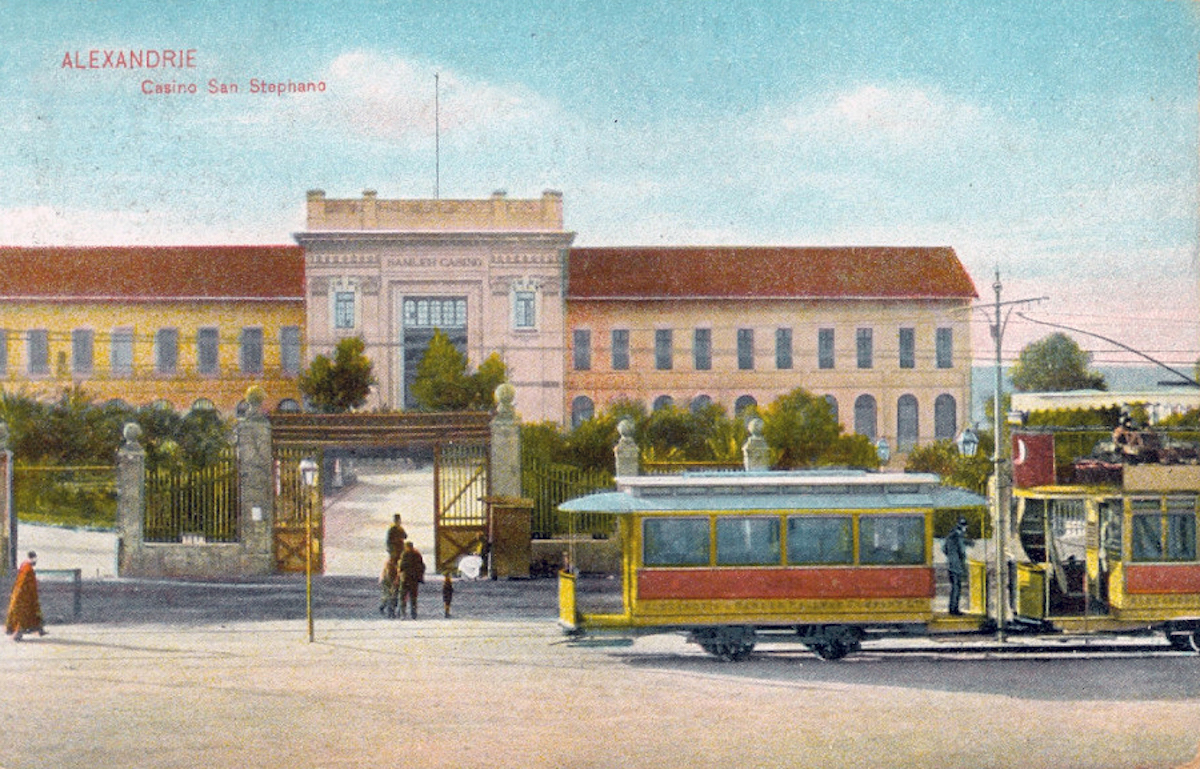 Passengers disembarking at the elegant Casino San Stephano, c. 1920, postcard view, public domain archival image
Passengers disembarking at the elegant Casino San Stephano, c. 1920, postcard view, public domain archival image
Honoured by the presence of Khedive Abbas Hilmi II — the last Ottoman Empire Viceroy to Egypt — the inaugural run of the Alexandria Tramway's electrified fleet was celebrated with a large public ceremony, complete with a well-attended procession of trams through the city centre. A symbol of much civic pride for Alexandria, the electrification of the Tramway signified the arrival of a new modern age for the ancient city.
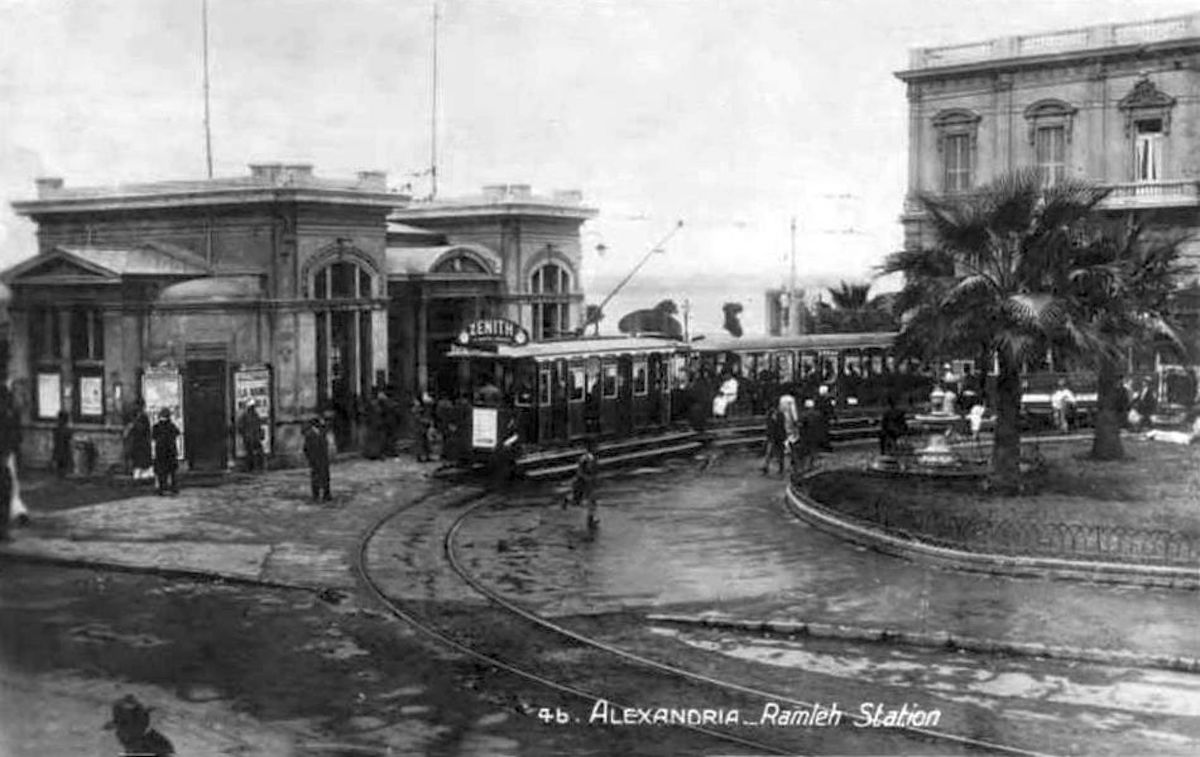 Ramleh Station, c. 1932, postcard view, public domain archival image
Ramleh Station, c. 1932, postcard view, public domain archival image
Into the 20th century, the Alexandria Tramway expanded and grew its fleet, eventually expanding to its present day length of 32 kilometres, with 140 stations and 20 discreet lines. Below, an archival 1914 map of Alexandria, with its tram and rail lines highlighted, reveals how little has changed in terms of the scale and scope of the city's street rail network, with passengers today travelling upon routes which in many cases date back more than a century.
 Alexandria Tram Map, c. 1914, public domain archival image
Alexandria Tram Map, c. 1914, public domain archival image
Over the years — particularly after the creation of the Egyptian Republic in 1953, which was followed by the rule of President Nasser from 1956 to 1970 — the fate of the Tramway became comparatively bleak. Its aging fleet was left to run down, supplemented only by the sporadic purchase of retired cars first from Toronto, and then from Copenhagen, over the course of the 1960s and early 1970s.
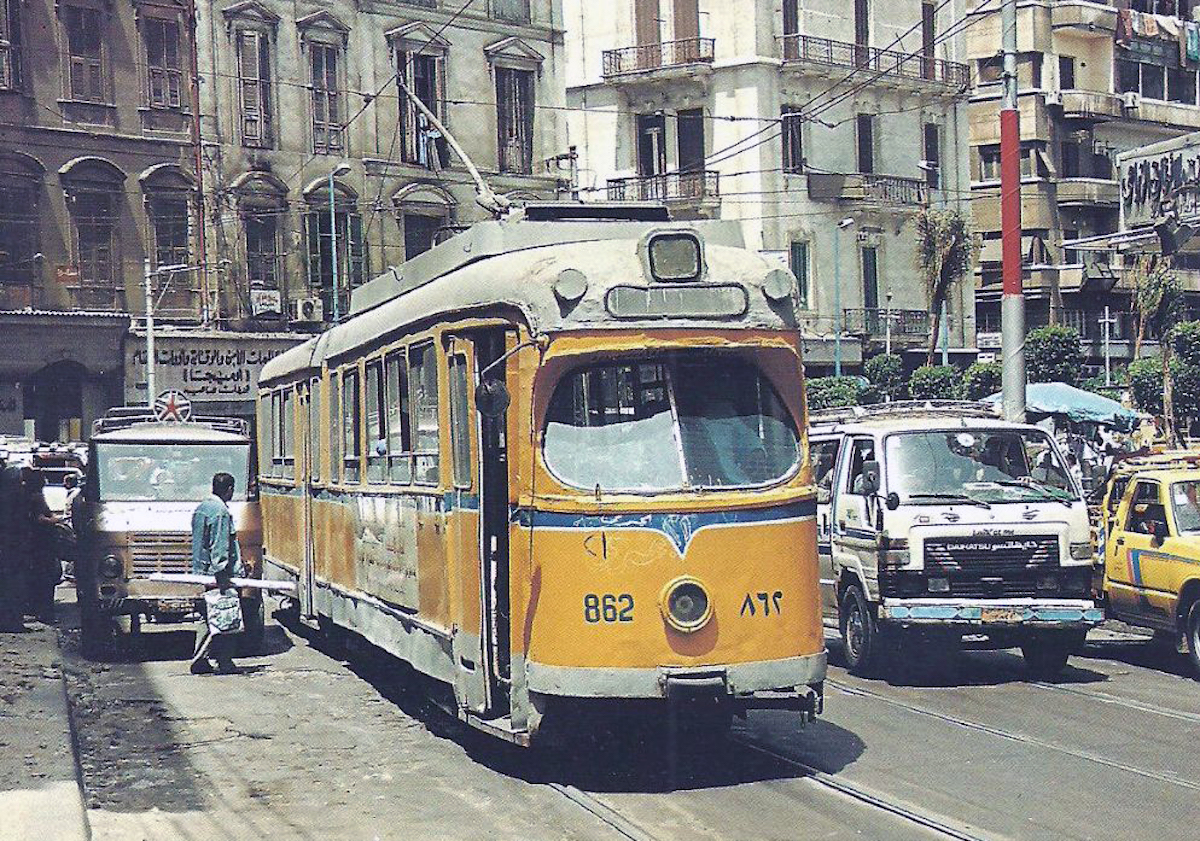 Ex-Copenhagen tram in operation on the streets of Alexandria, c. 1980s, public domain archival image
Ex-Copenhagen tram in operation on the streets of Alexandria, c. 1980s, public domain archival image
In 1968, the Alexandria Tramway Company imported 140 retired PCC cars, most of which came from Toronto, which were in operation until 1984. A few years later, in 1972, following the shuttering the of Copenhagen Tramway and subsequent retirement of its sizeable fleet, an additional 100 retired Copenhagen trams were imported. The vast majority of these remain in operation today, for better or worse. Recent reports reveal that the 90-odd Danish trams still in operation — albeit in varying states of repair — will be maintained until at least 2020.
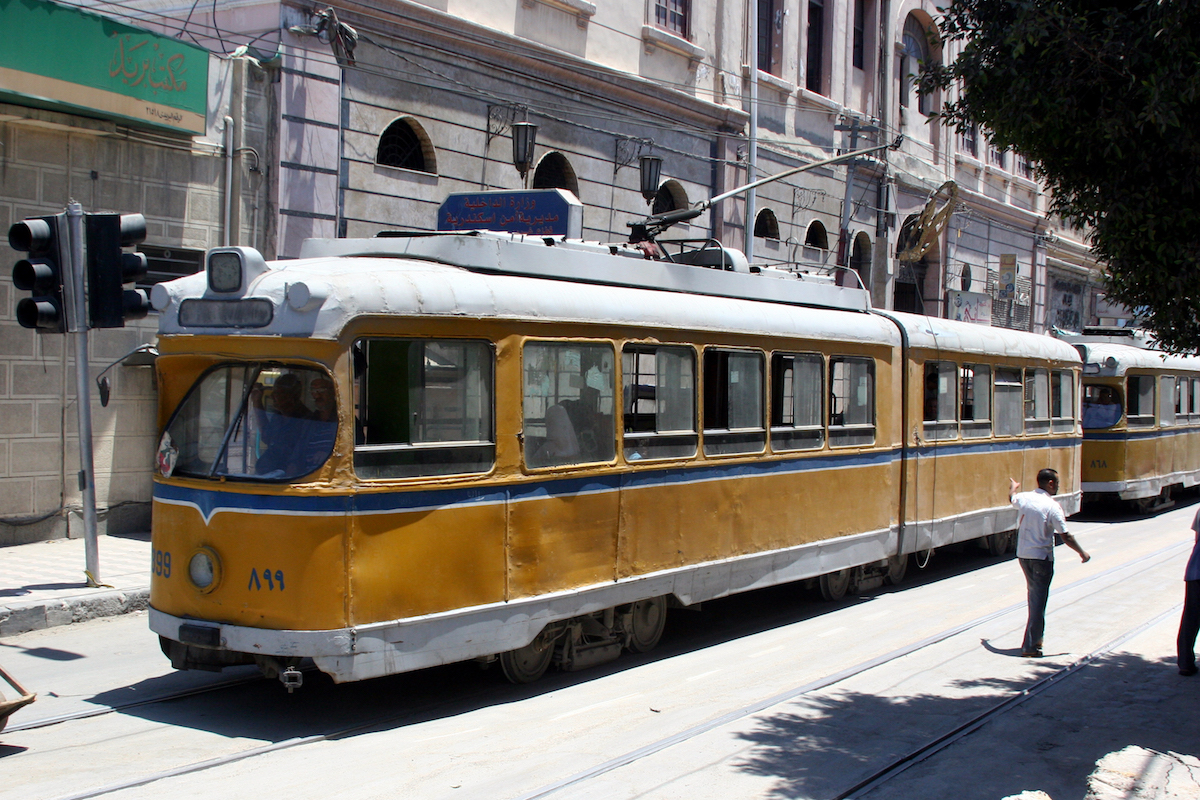 A row of Danish trams in operation in downtown Alexandria, image by Flickr user kmf164 via Creative Commons
A row of Danish trams in operation in downtown Alexandria, image by Flickr user kmf164 via Creative Commons
While the imported Danish trams still make up the bulk of the fleet, the Alexandria Tramway Company has continued to make use of other types of trams, including double-decker trams imported from various cites around the globe. Alexandria is one of only a few cities which now run these nearly extinct, British-origin, double-decker trams, which were once a staple of transit networks across the British Empire and Commonwealth.
 Japanese-built, 1980s-era, double-decker tram loading passengers in Alexandria, image by Wrightbus via Wikimedia Commons
Japanese-built, 1980s-era, double-decker tram loading passengers in Alexandria, image by Wrightbus via Wikimedia Commons
Viewed above, the Japanese-built, 1980s-era, double-decker tram has in more recent years become something of a status symbol in Alexandria, with higher fares and a more luxurious ride marketed almost exclusively to tourists and wealthy locals. The so-called "cafe trams," complete with tables, WiFi, and onboard food and beverage service, have garnered their fair share of controversy, however, viewed by critics as an exploitation of the class divide and a poor use of the resource-deprived public transit network.
 Blue, "Ladies Only" tram with both male and female riders on board, image by Flickr user Travel Aficionado via Creative Commons
Blue, "Ladies Only" tram with both male and female riders on board, image by Flickr user Travel Aficionado via Creative Commons
Less controversial, however, are the operation of several blue-painted "Ladies Only" trams, which give preference to female riders. This a nod to both the more traditional values within the country and the unfortunate reality of harassment, something that transit systems across the world have been slowly coming to terms with in recent years. While the rules of travel are not written in stone, the existence of various levels and types of cars and service are well-known to locals, while remaining ostensibly baffling to visitors attempting to get from point A to B.
While the majority of the footage included in this series has focused upon archival footage of trolleys and trams in operation at the turn of the last century in an attempt to contrast life as it was then to how it is today, much of the modern day footage above appears to resemble the level of urban chaos generally reserved for the past. Especially tangible towards the last half of the clip posted by YouTube user toemu2008, people, carts, wagons, and bicycles casually wander in and out of the path of moving trams during the nighttime scenes, and the trams themselves have been reduced to speeds not much faster than a brisk stroll. Evocative of similar streetcar footage from the early 20th century, there appears to be a much different spatial relationship between modes of transportation at work here, as the ancient city appears for a brief moment to be caught at the crossroads of antiquity and modernity.
SkyriseCities will return soon with a new edition of Once Upon a Tram, which will take an in-depth look at the transit legacy of a city near you. In the meantime, feel free to join the conversation in the comments section below. Got an idea for this series? Let us know!

 9K
9K 






























